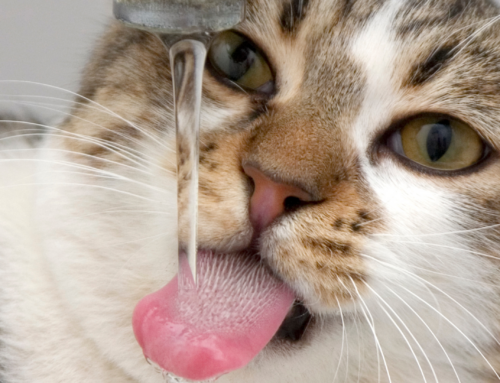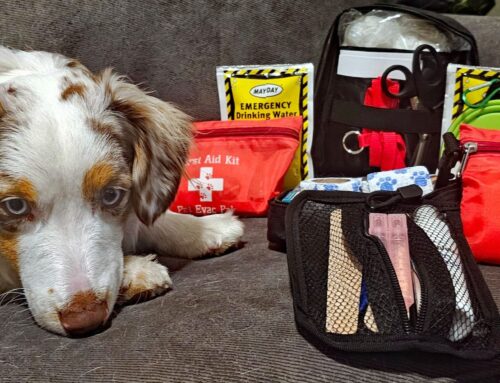As a senior pet owner, it’s crucial to have both short-term and long-term emergency plans in place for your furry family members. Whether it’s a quick trip to the grocery store, long-term care, or evacuating due to a natural disaster, having a plan can give you peace of mind that your pet will be safe. When creating your emergency plan, consider the following:
1. Short-term pet sitter: Always have a trusted friend or family member who can take care of your pet in case of emergency. Make sure they have access to your home and know your pet’s routine and needs. If you are in an accident having a wallet ID card identifying your short-term pet sitter can help first responders notify them your pet is home alone.

2. Long-term pet caregiver: In addition to a short-term pet sitter, it’s important to have a long-term caregiver for your pet in case you are hospitalized or unable to return home. Make sure this person is also familiar with your pet’s needs and has access to your veterinarian and they know where your pet’s emergency supplies are kept.
3. Make sure you have added your last wishes to your will so there is no question about what happens to your pet in your passing.
4. Emergency evacuation plan: If you have to evacuate due to an emergency or disaster, there are some things you can do now to ensure your pet’s safety down the road:
- Identification: In case you and your pet become separated, make sure your pet is microchipped and that your information is current and up to date. Additionally, make sure your pet has a collar with an ID tag with his name and your phone number on the tag. Microchipping can be done at any local veterinary office and sometimes can be accessible for seniors at local SPCA, or Animal Control offices at no charge.
- Vaccinations: If you need to board your pet during an emergency, ensure their vaccinations are up to date. Keep a copy of their vaccine records in your pet’s go-bag.
- Crate training: Make sure your pet is crate trained. This is a must if you have to go to a shelter during an emergency. Make this fun for your pet. To make sure you have the correct size your pet should be able to stand up and turn around in it comfortably. If your pet has never been in a crate start by putting the crate in a common area like your living room. Just open the door and put their favorite bed in it. Give them high-value treats in the crate for several days and never close the door. After a few days start closing the door for very short periods of time and then open it back up. After a while, your pet will start to sleep in it with the door open. Always make this their safe space and never punish them by putting them in the crate.

- Car rides: Most of us only take our pets with us (especially cats) when we have to take them to the Vet. This can cause some pets to be stressed out in the car. Try taking them for short fun trips, like taking them to the drive-through at Starbucks for a pupperchino, or just a short ride around the block and when you get home reward them with a high-value treat.
- Socialization: Socializing your pet by getting them out for daily walks can help them feel more comfortable and less anxious during a stressful situation. If you are unable to get out for walks, in most areas, you can hire a pet walker and some of them have some training experience. This can be helpful if your pet has some bad habits.
- Pet Emergency Go-Bag: If you have to evacuate for any reason your pet will need items that you might not have even thought about. Here is a list of what we recommend in your pet’s emergency kit. You should have a minimum 72-hour supply which is recommended by FEMA and the American Red Cross. You will usually know within 72 hours when you will be able to return home. Second, it can take emergency management 72 hours to get shelters set up.
- Water
- Food
- Bowls for food and water
- Basic first aid supplies
- First aid brochure
- Collar and leash or Slip lead
- Medication 5-days
- Shot records
- Waterproof pouch for documentation and medication
- Clip-on night light
- Mylar Blanket
- Favorite Toy
- Waste disposal – Poo Bags, cats will need Litterbox, litter and scoop
- ID card
- List of phone numbers for pet-friendly hotels, local animal control, boarding facilities and local veterinarians along your evacuation route.
- A photo of you with your pet can be helpful for identification should you get separated

All of these supplies should be stored in either a backpack, suitcase with wheels or something easy for you to manage with your pet should you need to get out quickly. If you are worried about tornadoes and plan on bugging in then a bucket in the center room of your home or basement will work. If this all seams too daunting, Pet Evac Pak has premade packs that can be delivered to your door for both dogs and cats. The only thing you would need to add is their medications and shot records.
Remember to rotate the food and water based on the expiration date on the bag or the bottles of water. Never repackage pet kibble as it can start to go bad within 3 weeks once it’s exposed to air.
By following these pet emergency prepping tips, you can ensure that your furry friend stays safe and protected during any situation.
Here is a list of resources to help older adults prepare for emergencies.
*** Note – High-value treat is something your pet really really loves. Could be chicken, hotdog or cheese for dogs and your cat might love tuna.





